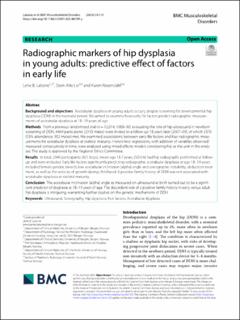| dc.contributor.author | Laborie, Lene Bjerke | |
| dc.contributor.author | Lie, Stein Atle | |
| dc.contributor.author | Rosendahl, Karen | |
| dc.date.accessioned | 2023-08-07T07:54:59Z | |
| dc.date.available | 2023-08-07T07:54:59Z | |
| dc.date.created | 2023-03-03T13:23:55Z | |
| dc.date.issued | 2023-02-11 | |
| dc.identifier.issn | 1471-2474 | |
| dc.identifier.uri | https://hdl.handle.net/11250/3082790 | |
| dc.description.abstract | Background and objectives: Acetabular dysplasia in young adults occurs, despite screening for developmental hip dysplasia (DDH) in the neonatal period. We aimed to examine how early life factors predict radiographic measurements of acetabular dysplasia at 18–19 years of age.
Methods: From a previous randomized trial (n = 12,014; 1988–90) evaluating the role of hip ultrasound in newborn screening of DDH, 4469 participants (2193 males) were invited to a follow-up 18 years later (2007–09), of which 2370 (53% attendance; 932 males) met. We examined associations between early life factors and four radiographic measurements for acetabular dysplasia at skeletal maturity. Hierarchical regressions, with addition of variables observed/measured consecutively in time, were analyzed using mixed effects models considering hip as the unit in the analyses. The study is approved by the Regional Ethics Committee.
Results: In total, 2340 participants (921 boys), mean age 18.7 years, (SD 0.6) had hip radiographs performed at follow-up and were included. Early life factors significantly predicting radiographic acetabular dysplasia at age 18–19-years included female gender, breech, low acetabular inclination (alpha) angle and sonographic instability, abduction treatment, as well as the velocity of growth during childhood. A positive family history of DDH was not associated with acetabular dysplasia at skeletal maturity.
Conclusion: The acetabular inclination (alpha) angle as measured on ultrasound at birth turned out to be a significant predictor of dysplasia at 18–19 years of age. The discordant role of a positive family history in early versus adult hip dysplasia is intriguing, warranting further studies on the genetic mechanisms of DDH. | en_US |
| dc.language.iso | eng | en_US |
| dc.publisher | BMC | en_US |
| dc.rights | Navngivelse 4.0 Internasjonal | * |
| dc.rights.uri | http://creativecommons.org/licenses/by/4.0/deed.no | * |
| dc.title | Radiographic markers of hip dysplasia in young adults: predictive effect of factors in early life | en_US |
| dc.type | Journal article | en_US |
| dc.type | Peer reviewed | en_US |
| dc.description.version | publishedVersion | en_US |
| dc.rights.holder | Copyright 2023 the authors | en_US |
| dc.source.articlenumber | 119 | en_US |
| cristin.ispublished | true | |
| cristin.fulltext | original | |
| cristin.qualitycode | 1 | |
| dc.identifier.doi | 10.1186/s12891-023-06199-y | |
| dc.identifier.cristin | 2131017 | |
| dc.source.journal | BMC Musculoskeletal Disorders | en_US |
| dc.identifier.citation | BMC Musculoskeletal Disorders. 2023, 24, 119. | en_US |
| dc.source.volume | 24 | en_US |

